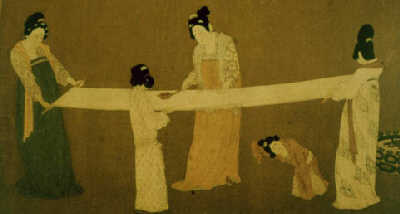The portrait painting style initiated by Yan Liben of the early Tang Dynasty, which had aimed at praising country heroes, gradually lost its appeal. In many Buddhist paintings, goddesses were modeled after imperial court ladies, a development that indicated religious painting was becoming more realistic, and that secular painting was beginning to take on its initial form. Zhang Xuan and Zhou Fang were two representative artists of the time.

Practicing and Workingby Zhuang Xuan
Zhang Xuan was a painter of the imperial court who was adept at drawing ladies, infants, horses and saddles. Forty-seven of his works were recorded in theXuanhe Painting Bookwritten in the Song Dynasty, but no authentic works by him are preserved. What we can see today are reproductions by Emperor Huizong of the Song Dynasty of Zhang'sSpring Travel of the Guo State QueenandPracticing and Working.
The Spring Travel of the Guo State Queen painting depicts the Guo State Queen, sister of the Emperor's most favored concubine Yang, who went for a spring trip with the Qin State Queen. The eight horseback-riding women in this painting are set in a well-conceived composition.
The spring atmosphere is revealed in the cheerful countenances of the ladies and their magnificent and beautiful clothes. Practicing and Working portrays scenes of the ladies exercising and sewing. The painting is divided into three parts; some figures are sitting, some standing, and they are looking at each other as if communicating. The painting vividly conveys the life interests of the imperial ladies in their detailed expressions and movements.
